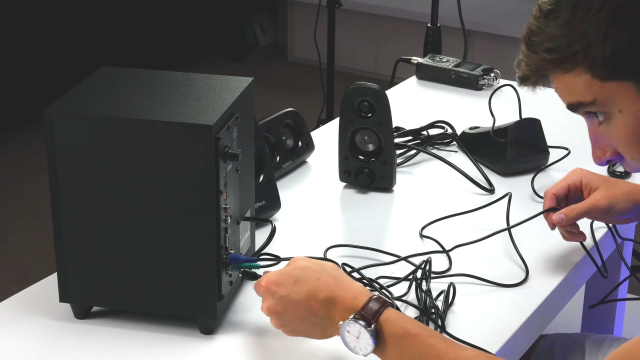Most audio receivers worth their salt come with a tiny microphone that you can use to automatically calibrate your speakers to your room’s specific setup. Easy.
But most people — unlike me — aren’t crazy enough to run their computer audio through a receiver just to get that delicious 5.1 surround sound in their geek dens.
If you’re sporting a fancier audio setup, you probably just have a 5.1 speaker system you plug directly into your desktop (or into your laptop via an external sound card.) And you probably haven’t taken any time to calibrate your audio and make it perfectly balanced for your room. Let’s fix that.
Get your test tones ready
Pull up Fraunhofer’s “HTML5 AAC Audio Playback Tests” and look for the “HE-AAC Channel ID – With H.264 Video” option. It’s a video that identifies your speakers via spoken voice — good for troubleshooting and calibrating, if you can get enough of a measurement from the spoken speaker names.
Windows users can also try using the operating system’s built-in “ding-ding-ding” speaker test sounds, found by clicking the Start button, typing in “Sound”, clicking on the first result, right-clicking on your speaker configuration, selecting “Configure Speakers”, and clicking on your various speakers in the handy graphic.
Otherwise, you might want to check out the “HD Audio Test Clips” listing at KODI. They aren’t ideal — as in, they don’t blast pink noise over your individual speakers in sequential order. However, clips such as the “DTS-HD MA 7.1 ‘Dredd’ Audio Channel Check”, downloaded and played through an app such as VLC, can at least help you manage your system’s audio levels. Download some clips; we’ll get to that in a bit.
If you’re a Netflix user, you can also access some test patterns directly within the service. Just type “test” when searching for a movie, select “Test Patterns”, and play the first “episode”.
Download a free audio-measuring app
There are plenty of apps for both iOS and Android that you can use to get a decent reading — in decibels — of any sounds blasting from your computer speakers.
For Android, consider grabbing the Sound Analyser App; for iOS, check out NIOSH Sound Level Meter. Both are free, and both do a decent job of estimating noise levels using your smartphone’s internal microphone.
While a smartphone app likely isn’t as accurate as an external microphone, they’re good enough for our purposes. (As an added bonus, both of these highlighted apps let you measure using “C” weighting, which receiver manufacturer Denon says is “the best match for the way we hear”.)
Make sure your system is set up correctly
This almost goes without saying, but make sure you’ve set up your operating system for your specific speaker configuration — whether you’re using a stereo or quadraphonic setup, a 5.1 system, 7.1 surround sound, et cetera.
On Windows, you’ll want to right-click on the speaker icon in the bottom-right corner of your Windows 10 taskbar, hover your mouse over “Speaker Setup”, and select your configuration.
On a Mac, click the Spotlight icon on your Menu Bar, type in “Audio MIDI Setup”, click on the first result, select the correct output, and click on the Configure Speakers button.
Measure your test tones and adjust levels accordingly
Sit behind your desk, on your geek den’s couch, or wherever you typically are, and position your phone around ear level, if you can. Pull up your audio-measuring app. Play a song or video and adjust your computer’s volume to a setting that sounds about as loud as you typically prefer.
Once you’ve done that, start playing your test tones through your speakers. Make a note of the approximate dB reading for each speaker, and then adjust its levels via your operating system’s controls until they all roughly match.
This should be obvious on a Mac. On Windows, you’ll have to right-click on your speaker configuration within the Sound window, click Properties, click the Levels tab, and click Balance.
As for your subwoofer — if you have one — you might just want to go ahead and set that up by ear, since your phone won’t be able to help you out. It’s easy to adjust your subwoofer’s physical volume dial, if it has one. Otherwise, you can also adjust its levels in your operating system.
When in doubt, remember that a little goes a long way. All you’ll need is one action-packed movie trailer to let you know if you’ve set the dial a little too high and your room sounds like one of those subwoofer-in-trunk cars that occasionally goes flying down your street.
Once you think your speaker system is balanced, pull up a piece of content you’re familiar with — your favourite movie, for example — and see how it sounds on your newly calibrated system. You can always make minor tweaks if your rear speakers are still giving you a little too much (or not enough), or if you prefer a little more dialogue from your centre channel, et cetera.
Having balanced levels across your speakers is great and all, but you should make sure your speaker setup sounds exactly how you like it.

Comments